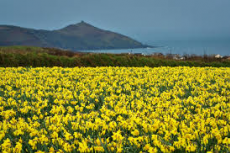
Email: ZYVC057@live.rhul.ac.uk
Total Article : 213
About Me:I'm a graduate student studying International Criminal Law and first started writing for King's News almost 4 years ago! My hobbies include reading, travelling and charity work. I cover many categories but my favourite articles to write are about mysteries of the ancient world, interesting places to visit, the Italian language and animals!

William Wordsworth, who lived in the 18th and 19th century, sparked what is known as the Romantic Age, an age of blissful poetry and pages of romance. One of his most famous and picturesque poems is Daffodils. In each passage of the poem the author sees true beauty in a common piece of nature, join us and discover what makes the daffodils in the beautiful Lake District where Wordsworth lived so uniquely beautiful.
Daffodils
I wander'd lonely as a cloud
That floats on high o'er vales and hills,
When all at once I saw a crowd,
A host of golden daffodils,
Beside the lake, beneath the trees
Fluttering and dancing in the breeze.
Continuous as the stars that shine
And twinkle on the milky way,
They stretch'd in never-ending line
Along the margin of a bay:
Ten thousand saw I at a glance
Tossing their heads in sprightly dance.
The waves beside them danced, but they
Out-did the sparkling waves in glee: -
A poet could not but be gay
In such a jocund company!
I gazed - and gazed - but little thought
What wealth the show to me had brought.
For oft, when on my couch I lie
In vacant or in pensive mood,
They flash upon that inward eye
Which is the bliss of solitude;
And then my heart with pleasure fills
And dances with the daffodils.

Analysis
The poem is made of four six-lined stanzas and follows a specific rhyming pattern: ABABCC. It is quite a simple poem in which Wordsworth observes an object of nature which would normally be ignored by many. Wordsworth states that as he wandered around the lake he came across a field of beautiful daffodils. The daffodils were dancing and prancing freely in the breeze and stretched endlessly, quite like the infinity of stars in the sky above us. At such a beautiful sight of nature one could only be filled with joy and serenity, for who could not love the gleeful daffodils. In the last stanza the poet says that when he is sitting on his sofa, in a thoughtful and pensive mood, the image of these wonderful daffodils would appear in his mind and bring him great pleasure in his moment of solitude. The author specifically uses the term inward eye as Wordsworth believed that a poet has something unique that distinguishes him/her from the mass; they have the ability to access their inward eye, also known as their imagination, and can see beyond the materialistic views of an object realising its true beauty. This talent was emphasised during the Romantic Age, which emerged in the 18th century as a reaction against the mechanical ways of the industrial revolution which had stripped nature of its true beauty and a revolt against the rigid aristocratic politics of the Age of Enlightenment. As poets of the Romantic Age began to express their innermost thoughts and imagine a world beyond reality, a world of true beauty and romance, joy and serenity where even daffodils, some of the most common of flowers, can come alive as their beauty shines through.
Image 1: https://onceadaypoetry.files.wordpress.com/2012/03/daffodils-poem.jpg
Image 2: http://hightechhunt.com/wp-content/uploads/2013/01/daffo.jpg

0 Comment:
Be the first one to comment on this article.